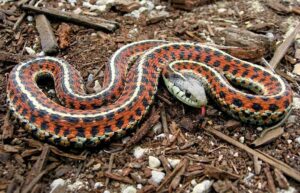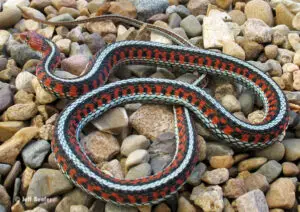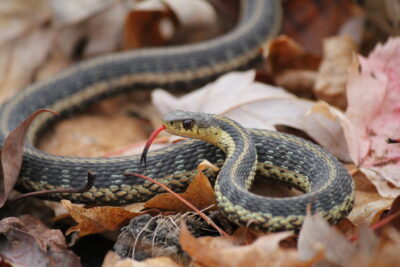Garter snakes are fascinating reptiles known for their slender bodies, vibrant colors, and widespread distribution across North and Central America. These non-venomous snakes primarily feed on a diet of small prey such as insects, earthworms, amphibians, and small rodents. But how often do garter snakes eat?
Garter snakes are ectothermic, meaning their metabolic rate depends on their environmental temperature. As a result, their feeding frequency can vary based on temperature, age, and individual differences. Generally speaking, adult garter snakes can go several days to a week or more between meals, especially during cooler periods or when they’re not very active.
During warmer months, when they are more active, they may eat more frequently, sometimes every few days. Juvenile garter snakes tend to eat more frequently than adults because they are growing rapidly.
It’s essential to offer appropriately sized meals for their size and to observe their behavior to determine if they are hungry. Always provide a varied diet and ensure that their food is nutritionally balanced to keep them healthy.
Types of prey consumed by garter snakes

Garter snakes are opportunistic feeders and have a varied diet that primarily consists of small prey. Here are some common types of prey consumed by garter snakes:
- Amphibians: Garter snakes often feed on frogs, toads, and salamanders. They can be particularly fond of amphibians and may actively hunt them near water bodies.
- Fish: Near aquatic habitats, garter snakes may consume small fish. They are capable of hunting fish in shallow waters.
- Earthworms: Earthworms are a staple in the diet of many garter snakes. They are a readily available and nutritious food source.
- Insects and Invertebrates: Garter snakes will also eat a variety of insects, including grasshoppers, crickets, caterpillars, and beetles. They may also consume other invertebrates like slugs and snails.
- Small Mammals: Occasionally, garter snakes may consume small mammals such as mice, voles, and shrews, especially the larger species or when food is scarce.
- Birds: While less common, some garter snake species have been known to eat small birds or their eggs.
- Other Reptiles: In rare instances, garter snakes may prey on smaller snakes or lizard species.
It’s essential to provide a varied diet in captivity to ensure they receive all the necessary nutrients. Always offer appropriately sized prey items relative to the snake’s size, and make sure any wild-caught prey is free of pesticides and parasites.
How often do garter snakes eat
Garter snakes have a varied metabolism influenced by factors like environmental temperature, age, and activity level. As ectothermic animals, their metabolic rate is tied to their environment, meaning they need external heat sources, like sunlight, to regulate their body temperature and metabolic activity.
- Temperature Influence: In cooler temperatures, garter snakes have a slower metabolism and may eat less frequently. During colder periods or when they are less active, they can go several days to a week or even longer without eating.
- Activity Level: During the warmer months, when garter snakes are more active, they tend to eat more frequently. The increased activity and higher metabolic rate mean they require more energy, leading to more frequent feeding.
- Age: Juvenile garter snakes have a higher growth rate and metabolism compared to adults. As a result, they typically eat more frequently to support their rapid growth and energy requirements.
- Individual Differences: Individual snakes can have different appetites and metabolic rates. Some snakes might eat more often due to their natural disposition or previous feeding habits.
In captivity, it’s essential to monitor the snake’s behavior and body condition to determine its feeding frequency. Offering appropriately sized meals is crucial, and it’s recommended to provide a varied diet to ensure nutritional balance.
Factors influencing feeding frequency

The feeding frequency of garter snakes can be influenced by various factors. Understanding these factors can help you determine how often to feed your garter snake in captivity:
- Environmental Temperature: Being ectothermic, garter snakes rely on external sources to regulate their body temperature. Cooler temperatures generally slow down their metabolism, reducing their feeding frequency. In contrast, warmer temperatures increase metabolic rates, prompting more frequent feeding.
- Age: Juvenile garter snakes have higher metabolic rates due to growth and development. They typically require more frequent feedings compared to adult snakes.
- Activity Level: More active snakes, especially during warmer months, burn more energy and may need to eat more often to sustain their activity levels.
- Digestive Status: After consuming a meal, a snake needs time to digest its food fully. They might not eat until the previous meal is completely digested, affecting the feeding frequency.
- Health and Body Condition: Snakes that are sick or have health issues may have reduced appetites and eat less frequently. On the other hand, obese snakes might require less frequent feeding to maintain a healthy weight.
- Reproductive Cycle: Breeding females might eat less frequently or refuse food altogether when gravid (pregnant). Males may also have reduced appetites during the breeding season.
- Availability of Prey: In the wild, the availability of prey can influence feeding frequency. A scarcity of food might cause snakes to eat less often.
- Previous Feeding Habits: Individual snakes can develop preferences and habits based on their previous feeding experiences. Some snakes might be more voracious eaters, while others might eat less frequently.
When keeping garter snakes in captivity, it’s essential to monitor their behavior, body condition, and feeding responses to determine the ideal feeding frequency. Providing a balanced diet with appropriately sized prey items is crucial for their health and well-being.
Consulting species-specific care guides and observing your snake’s individual needs will help you establish a suitable feeding schedule.
Feeding Patterns in Different Life Stages
Feeding patterns in garter snakes can vary depending on their life stages. Let’s explore how the diet of garter snakes changes as they grow.
Juvenile Stage: Juvenile garter snakes primarily feed on small prey such as insects, earthworms, slugs, and small amphibians. They have relatively small mouths and consume prey that they can easily overpower.
Sub-Adult Stage: As garter snakes grow, their diet expands to include larger prey items. During the sub-adult stage, they begin to consume larger prey such as small fish, larger amphibians, and sometimes even small mammals like voles or mice.
Adult Stage: Adult garter snakes have a varied diet that typically includes a wide range of prey. They feed on fish, amphibians, small mammals, birds, and their eggs, as well as various invertebrates. Garter snakes are opportunistic feeders and will consume whatever prey is available in their habitat.
Throughout all stages of life, garter snakes are primarily carnivorous, but they may occasionally consume plant matter, such as fruits or berries. Their diet largely depends on the availability of prey in their environment and their ability to catch it.
Signs of Hunger or Overfeeding

Recognizing signs of hunger or overfeeding in garter snakes is crucial for maintaining their health. Here are some signs to look out for:
Signs of Hunger:
- Increased activity: Hungry garter snakes may become more active in their enclosure, constantly searching for food.
- Tongue flicking: If your snake is flicking its tongue more frequently than usual, it could be a sign of hunger.
- Pacing: Restless behavior, including pacing along the enclosure walls, may indicate hunger.
- Aggressiveness at feeding time: If your snake strikes at its prey more aggressively than usual, it may be particularly hungry.
Signs of Overfeeding:
- Obesity: Garter snakes that are overfed may become overweight, leading to visible bulges along their bodies.
- Reduced activity: Overfed snakes may become lethargic and less active than usual.
- Regurgitation: If a snake has been overfed, it may regurgitate partially digested food.
- Difficulty shedding: Overweight snakes may have difficulty shedding their skin properly.
- Reduced appetite: Paradoxically, overfed snakes may lose interest in food due to feeling full.
Monitoring your garter snake’s feeding schedule and behavior can help prevent both hunger and overfeeding. Adjust feeding frequency and portion sizes accordingly to maintain your snake’s health and well-being.
Feeding Tips for Pet Garter Snakes
Feeding pet garter snakes requires attention to detail to ensure they receive proper nutrition and maintain good health. Here are some feeding tips:
1. Choose appropriate prey:
- Offer a variety of prey items, including earthworms, slugs, small fish, amphibians, and appropriately sized rodents.
- Prey should be no wider than the widest part of the snake’s body.
2. Feed according to age and size:
- Juvenile snakes may require smaller prey more frequently, while adults can be fed larger prey less often.
- Feed juvenile garter snakes every 4-5 days, sub-adults every 7-10 days, and adults every 10-14 days.
3. Feed in a separate enclosure:
- Consider using a separate feeding enclosure to prevent substrate ingestion and reduce stress during feeding.
- Never feed your snake in its primary enclosure, as this can lead to substrate ingestion and potential health issues.
4. Maintain proper temperatures:
- Ensure that the temperature gradient in the enclosure is appropriate for digestion.
- After feeding, provide a warm basking spot (around 85-90°F or 29-32°C) to aid digestion.
5. Monitor feeding behavior:
- Keep an eye on your snake during and after feeding to ensure it consumes the prey without any issues.
- If your snake regurgitates its food, wait at least a week before attempting to feed it again.
6. Hydration is important:
- Always provide access to clean, fresh water in a shallow dish.
- Soak your snake in lukewarm water if it is not drinking on its own, or if it is showing signs of dehydration.
7. Avoid overfeeding:
- Overfeeding can lead to obesity and other health issues.
- Offer appropriately sized prey items to prevent overfeeding.
By following these feeding tips, you can help ensure that your pet garter snake remains healthy and happy. If you have any concerns about your snake’s feeding habits or overall health, consult a reptile veterinarian for guidance.
Conclusion
How often garter snakes eat depends on their age and size. Juveniles may eat every 4-5 days, while sub-adults may eat every 7-10 days, and adults may eat every 10-14 days. It’s essential to monitor feeding behavior and adjust the feeding schedule accordingly to ensure your garter snake remains healthy and maintains proper nutrition.

